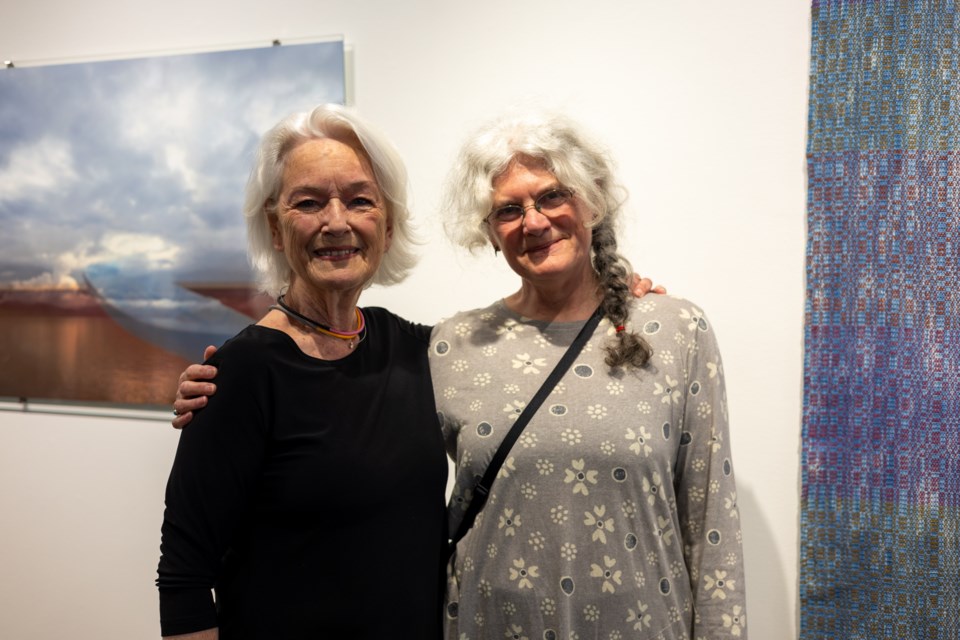The capricious nature of reality — and our hunger to tie it down through symbols and images — are portrayed in two new exhibitions unveiled at the Gibsons Public Art Gallery last week.
Works by textile artist Joanna Rogers (from Pender Island) and Gibsons-based photographer Ines Tancré inveigle viewers with familiar forms, then gradually reveal deeper meanings, which are grounded in language. The two artists were present for a public reception at the gallery on May 4.
Rogers’s hand-woven and dyed textile banners (arrayed as The Chorus) and paleolithic-style war belts (Still Fighting, in their first-ever appearance) carry the allure of organic antiquity. But messages are spliced into each work, using the dits and dahs of Morse code. Rogers was inspired by the analytical engine of computing pioneer Charles Babbage, whose design was based on the mechanical loom. Encoded in her fabrics are verses that function as warnings, laments, or both.
Words by poet William Butler Yeats are worked into the mercerized cotton warp and weft of I Will Arise: “And I shall have some peace there, for peace comes dripping slow.” In the pomegranate-dyed war belt dedicated to feminist icon Sylvia Pankhurst, Lewis Carroll’s Jabberwocky is knotted, letter by letter: “All mimsy were the borogoves, / And the mome raths outgrabe.”
Garments modelled on a vintage woman’s shift (a type of smock) are titled What Once Was: The Apocalypse is Now. Rogers dyes the cloth in vats of iron, tannins and indigo before adding natural elements. In What Once Was: Antarctica, the blue-white garment is slung with bubble wrap, seal bones and sea bird feathers. Its dire prophecy is clear.
“We always think of the apocalypse as being some future event that’s going to happen very quickly,” said Rogers, who holds university degrees in both anthropology and textile arts. “It could also be the period of time that we’re in right now. These shifts represent pieces that could have been recently unearthed or from the future. They represent something in the past that hasn’t happened yet. They represent species and ecosystems that we’re losing now and that could very well be completely lost in the future.”
For German-born artist Ines Tancré, her academic expertise in linguistics and philosophy is expressed through a body of work titled In-Versions. Tancré’s photographic and mixed-media artworks are meticulously organized using a six-part taxonomy. Throughout her fracturing nature series, black-and-white images depict the use and abuse of natural landscapes, as verdant hills and pastures are marked by otherworldly striations. The touching series inverts objects and their shadows: in Scape V, a ghostlike dinghy hovers above a russet sea.
“In all my work I am showing what is happening between opposites,” said Tancré, “between light and dark, and between white and black, and between good and bad. Where reality comes in is all reality, and depends on how we look at it, where we stand with our perspective.”
Tancré’s work is simultaneously rooted in glimpses of local geographies (as in the abstract-annotated seascape of Script II: If you only found a way) and the global perspective she acquired while living in Iran, Sierra Leone, Norway, Egypt, Germany, Italy, the U.S. and Austria.
Her art features fleeting flashes of narrative. Tancré’s script series adapts Ernest Hemingway’s shortest of short stories (“For Sale: Baby shoes, never worn.”) into a series of abstracts interlaced with seductive hieroglyphics. In the centre of _Script III: writing with moonlight on dark days_, a brilliant orb breaks through a thicket of serpentine ciphers.
Joanna Rogers’s Hanging By a Thread: The Illusion of Permanence and Ines Tancré’s In-Versions continue at the Gibsons Public Art Gallery until May 26.



